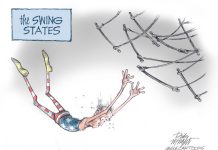The (Norfolk, Va.) Virginian-Pilot and Daily Press
The White House’s latest effort to tackle the difficult problem of suicide among the military and veterans may be the comprehensive approach that’s sorely needed. It could help a lot of people across the nation.
The new strategy, announced the week before Veterans Day, is promising and deserves support.
Skeptics will be forgiven, since we’ve heard a lot of this before. The rate of suicides among the military and veterans has remained alarmingly high for a decade or more, despite the well-publicized vows of the last three presidential administrations to make this crisis a priority.
The statistics are grim. Since the Sept. 11, 2001, terrorist attacks, about four times more military members and veterans have died of suicide than have been killed fighting. In 2019, the most recent year for which the Department of Veterans Affairs has statistics, about 17 veterans a day died by suicide — and that was before COVID-19 brought more isolation and depression. The rate of suicide among military members and veterans is 1.5 times that of American civilians.
Rightly calling suicide among service members, veterans and their families “a public health and national security crisis,” the Biden administration’s strategy calls for building on existing programs and adding more in a drive toward real progress.
It’s a comprehensive strategy that will involve departments and agencies across the federal government in addition to the departments of Defense and Veterans Affairs.
It intends to improve ways to deal with people in times of crisis and at risk of suicide. It also takes a broader approach designed to address the many causes of suicide with an eye to keeping military members and veterans from reaching that moment of crisis.
It recognizes that just as there are many reasons people are driven to suicide, there is not a one-size-fits-all solution.
The plan emphasizes expanding existing efforts to identify military members and veterans struggling with mental health problems, doing more to intervene before a crisis, and making it easier for those in crisis to get emergency help.
The plan will expand efforts to make high-quality mental health care easily available and affordable for military members, veterans and their families.
One of the most important aspects of the comprehensive strategy involves correcting the problems that lead service members and veterans to the brink of suicide. That’s a challenge, because there are many reasons that go beyond the common factors, such as post-traumatic stress disorder. And many service members and veterans are reluctant to ask for help when they need it.
This effort will address basic things such as pay, benefits, family stresses and the difficulty of making the transition from military to civilian life. Too many veterans struggle with homelessness, unemployment, substance abuse and other problems that contribute to hopelessness.
The 20 years of war since Sept. 11 have put great stresses on the men and women who volunteer to serve in our military and protect our nation. The government and society as a whole have done a poor job helping them deal with their emotional and mental-health problems.
The new, expanded emphasis has the potential to make a difference. Let’s do what we can to make it work.
Send comments to [email protected].




